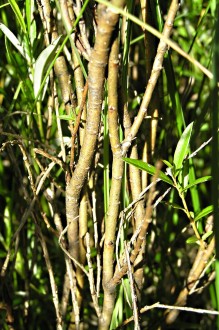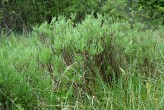(Salix rosmarinifolia L.)
Habitus
- it is a low shrub, 20 – 100 cm high, the stem is creeping up to 1 m long, the branches are ascending
- the bark on younger stems and branches is greenish-gray, smooth
Buds
- buds are tiny, conical to ovate, 2 - 3 mm in size
- they are reddish-brown, silvery hairy, later partially balding
Shoots
- shoots (shoots) are thin, greenish-brown to reddish, dull, hairy
Leaves (assimilation organs)
- the leaves are simple, linear-lanceolate, widest in the lower half with 10 -12 pairs of veins
- the leaves are 10 - 45 mm long (4 -10 times longer than the wider ones)
- on the obverse they are dark green, grey-tomentose, later balding, shiny
- silvery hairy on the reverse, marginal entirety, rolled up at the edge
- the peduncle is up to 0.5 cm long, shortly silky hairy, later glabrous
Flowers
- it is dioecious tree species
- flowers are in catkins
Fruits – seeds
- the fruit is a capsule
- the seed is downy achene
Extension
- it has a Eurasian range of distribution, especially in northern, central and eastern Europe
- in Slovakia, it occures mainly in the Tatra region
Ecology
- typical habitats of rosemary-leaved willow are peatlands, wet sands, meadows, pastures, peat bogs
- it grows on a variety of soils and mineral substrates
- in Slovakia, it rises to about 1,000 m above the sea level.
Significance
- practical use with regard to ecological characteristics can be found in the creation of garden greenery, mainly for its short stature and decorative silvery-tomentose leaves
- level of threat in Slovakia - vulnerable species (VU), protected by law















